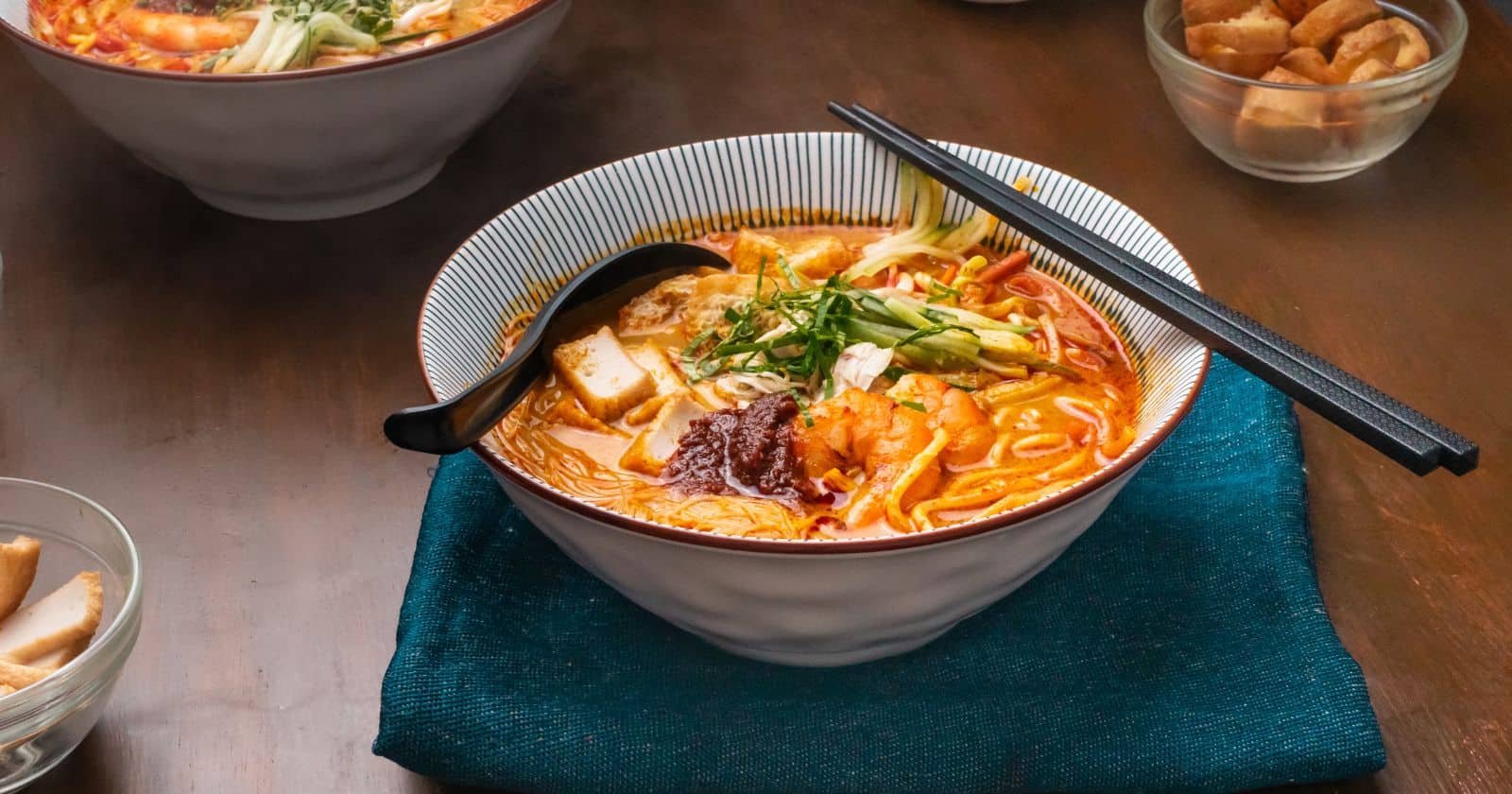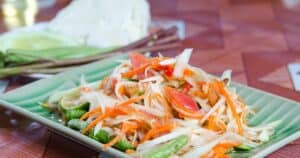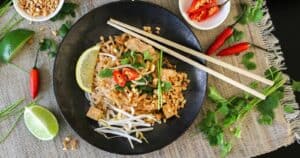Spice up your taste buds with a fiery showdown between two Southeast Asian soup sensations – Tom Yum soup and Laksa! These popular dishes are known for their bold flavors and spicy kick, but what sets them apart? Let’s dive into the tantalizing world of Tom Yum soup and Laksa, exploring their origins, unique ingredients, and flavor profiles.
While both Tom Yum soup and Laksa will satisfy your craving for a spicy and flavorful soup, they each offer a distinctive taste experience.
Tom Yum soup hails from Thailand, with its tangy and hot flavors derived from a blend of lemongrass, galangal, kaffir lime leaves, and chilli peppers.
On the other hand, Laksa, originating from Malaysia and Singapore, tempts your taste buds with a creamy and spicy coconut milk-based broth infused with curry paste and a delicate blend of spices.
The Origins of Tom Yum Soup and Laksa
Tom Yum soup is a beloved dish that originated in Thailand during the Rattanakosin Kingdom. This bold and spicy soup is known for its hot and sour flavors, making it a favorite among Thai cuisine enthusiasts.
The name “Tom Yum” comes from two Thai words: “Tom” which means boiling, and “Yum” which signifies mixing. The soup is traditionally prepared with a clear fish broth and served with rice. It incorporates a variety of ingredients, including lemongrass, galangal, kaffir lime leaves, chili, lime juice, fish sauce, and shrimp or other proteins.
On the other hand, Laksa is a spicy noodle soup that is highly popular in Southeast Asia, especially in Malaysia and Singapore. While its exact origins remain uncertain, Laksa is believed to have been influenced by Chinese and Malay cuisine.
This delectable soup is typically crafted with a spicy coconut milk-based broth, rice noodles, and various toppings like shrimp, chicken, tofu, and vegetables. Its remarkable combination of flavors and textures has made it a popular choice among locals and tourists alike.
Flavor Profiles: Tangy and Hot vs Creamy and Spicy
Tangy and Hot:
- Tom Yum soup is a popular Thai soup known for its hot and sour flavor.
- Made with ingredients like lemongrass, galangal, kaffir lime leaves, chili peppers, and shrimp or chicken.
- The soup base is typically water, coconut milk, or chicken broth.
- Usually served with rice.
Creamy and Spicy:
- Laksa is a popular Malaysian and Indonesian soup known for its creamy and spicy flavor.
- Made with ingredients like coconut milk, curry paste, shrimp paste, fish, chicken, or tofu, and noodles.
- Toppings for Laksa include bean sprouts, tofu puffs, and hard-boiled eggs.
- Usually served with noodles and toppings like bean sprouts and tofu puffs.
In Southeast Asian cuisine, two distinct flavor profiles can be found in popular soups: tangy and hot, and creamy and spicy. Tom Yum soup, a famous Thai dish, falls into the tangy and hot category. It boasts a hot and sour flavor that delights the taste buds.
The soup is prepared with ingredients such as lemongrass, galangal, kaffir lime leaves, chili peppers, and options like shrimp or chicken. The base for Tom Yum soup can be water, coconut milk, or chicken broth. To complete the meal, it is often served with rice.
In contrast, Laksa, a renowned Malaysian and Indonesian soup, belongs to the creamy and spicy profile. This soup offers a rich and spicy taste that is complemented by its creamy texture. Made with ingredients like coconut milk, curry paste, shrimp paste, fish, chicken, or tofu, the soup provides a harmonious blend of flavors.
Laksa is typically served with noodles, which soak up the delightful broth. Toppings such as bean sprouts, tofu puffs, and hard-boiled eggs add extra texture and flavors to the dish.
Unique Ingredients in Tom Yum Soup and Laksa
Tom Yum Soup is renowned for its bold and vibrant flavors, thanks to its unique ingredients. Some of these distinctive components include:
- Lemongrass: This aromatic herb adds a tangy and lemony flavor to the soup, providing a refreshing and zesty taste.
- Galangal: A rhizome similar to ginger, galangal adds a citrusy and floral flavor to the soup, enhancing its overall aroma.
- Kaffir lime leaves: These leaves contribute a distinct citrus fragrance and a subtle bitterness to the soup, adding depth to the flavor profile.
- Thai chilies: Known for their fiery heat, these chilies infuse the soup with spiciness, elevating its taste to a whole new level.
- Fish sauce: A staple in Thai cuisine, fish sauce lends a savory and umami flavor to the soup, enhancing its overall complexity.
- Shrimp or other proteins: Tom Yum Soup often includes shrimp, which adds a delicate sweetness to the broth. However, other proteins like chicken or tofu can also be used to cater to different preferences.
- Thai basil: This aromatic herb adds a hint of licorice and mint flavors to the soup, providing a refreshing and fragrant note.
Moving on to Laksa, this Malaysian soup has its own set of unique ingredients:
- Laksa paste: Made from a blend of spices and herbs such as lemongrass, galangal, turmeric, and chili, the paste forms the base of Laksa and imparts its signature flavor.
- Coconut milk: This creamy and rich ingredient forms the backbone of Laksa, giving it a smooth and luscious texture while adding a subtle sweetness.
- Rice noodles: These thick noodles soak up the flavorful broth and provide a hearty and satisfying element to the dish.
- Shrimp, chicken, tofu, or other proteins: Like Tom Yum Soup, Laksa offers various protein options to cater to different preferences. Shrimp, chicken, tofu, or a combination can be added, enhancing the overall taste and texture.
- Bean sprouts: These crunchy and refreshing sprouts add a nice contrast to the rich and savory components of Laksa, providing a textural element.
- Laksa leaves: Also known as Vietnamese coriander, these aromatic leaves have a unique flavor that is peppery, citrusy, and slightly minty. They heighten the taste of Laksa and give it a distinctive edge.
Exploring Protein Options for Tom Yum Soup and Laksa
Tom Yum Soup and Laksa are two popular Southeast Asian soups known for their delicious flavors and diverse protein options. Let’s delve into the various protein options available for both soups.
Tom Yum Soup:
- Shrimp or pork: Traditionally, Tom Yum soup includes succulent shrimp or tender pork as the main protein source. These options provide a delightful taste and texture to the soup.
- Meat-free alternatives: For those preferring a vegetarian or vegan option, Tom Yum soup can be made with tofu and mixed vegetables. This protein alternative adds a wonderful plant-based element to the soup.
- Chicken, fish, and mushrooms: Besides the traditional options, other proteins that can be used in Tom Yum soup include chicken, fish, and mushrooms. These ingredients offer unique flavors and options for those looking to diversify their soup experience.
Laksa:
- Shrimp, fish, chicken, or tofu: The most common protein options in a bowl of Laksa are shrimp, fish, chicken, or tofu. These proteins infuse the soup with their distinct tastes and textures.
- Beef, pork, and vegetables: On top of the usual protein choices, Laksa can also be made with beef, pork, or a combination of vegetables such as eggplant and okra. These additions allow for a versatile and customizable dish, catering to different dietary preferences and palates.
Serving Suggestions: Rice or Rice Noodles?
When it comes to serving Tom Yum soup, both rice and rice noodles are excellent options. The main article about Tom Yum soup vs Laksa highlights the versatility of these two ingredients. Here’s a closer look at why both rice and rice noodles work well with these popular soups:
Tom Yum Noodle Soup:
One way to enjoy Tom Yum soup is by cooking rice noodles separately and then pouring the flavorful soup over them. This method allows the noodles to absorb the delicious broth, resulting in a satisfying and slurp-worthy dish.
Tom Yum with Sticky Rice:
Serving Tom Yum soup with sticky rice as a main dish. This combination offers a contrasting texture to the soup and allows for a more substantial meal. The sticky rice can be enjoyed alongside the soup or even used to mop up the flavorful broth.
Laksa with Rice Noodles:
When it comes to Laksa, rice noodles are the customary choice for this Southeast Asian dish. These thin, tender, and translucent noodles are perfect for absorbing the rich and fragrant curry broth of Laksa, enhancing the overall taste and experience of the dish.
The Culinary Adventure of Southeast Asian Flavors
The Culinary Adventure of Southeast Asian Flavors is a cookbook that takes readers on a journey through the vibrant and diverse cuisines of Thailand, Vietnam, Malaysia, and Singapore. With over 100 recipes and 700 photographs, this book aims to demystify Southeast Asian cuisine and make it accessible for home cooks.
One of the highlights of this cookbook is the tantalizing array of dishes it offers. From fragrant curries to sizzling stir-fries, delectable street food to refreshing tropical desserts, there is something to tempt every palate. The recipes are accompanied by vivid anecdotes that provide insight into the flavors and techniques of Southeast Asian cooking.
Authored by Robert Danhi, Jay Weinstein, and Martin Yan, this book combines their years of photography, culinary training, education, and expertise into an adventure for food enthusiasts. It is the perfect resource for anyone looking to learn about the flavors of Southeast Asian cuisine and recreate these delicious dishes at home.





